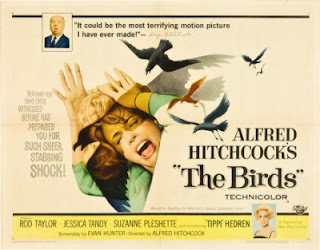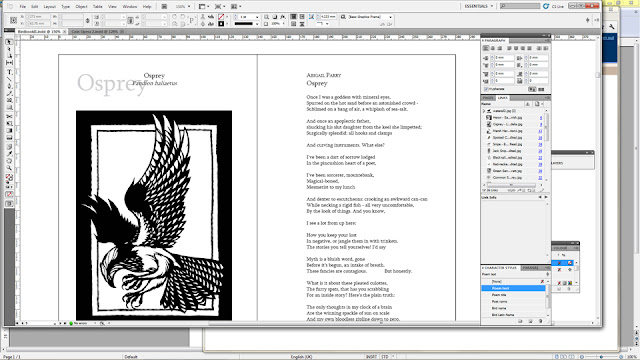Like many people, I love The Birds (1963), Hitchcock’s tale of love troubled by dark forces in sunny California. And it’s a film I’ve been thinking about recently, partly in response to the various bird images and poems that have been circulating the Sidekick Books command centre ahead of the publication of Birdbook: Freshwater Habitats, volume two of Kirsty and Jon’s planned series celebrating the bird inhabitants of Great Britain. What I’ve been thinking about in particular is the relationship between the birds and the people that the film depicts and what we might make of it, particularly if we are interested in the relationship between animals and people in real life. Is it right to say, for example, as many critics have said, that the birds are there to express something significant and meaningful about the human characters or their relationships? Is there something else that they are there to do? Or is it possible to see the film as being in some way ‘about’ birds and our relationship with them?
The Birds is a frightening and shocking film in some respects – I can’t imagine many viewers forget the image of Dan Fawcett with his eyes pecked out – but it is also a self-consciously arty one, amply supplied with enigmatic compositions and Freudian banter and committed to a fairly radical form of narrative in which strange phenomena remain unexplained and the protagonists’ fate still hangs in the balance when the screen fades to black for the final time (Hitchcock had arranged to watch European art films by Antonioni, Bergman and others before making The Birds, and a number of his ideas for the film were a good deal stranger than his scriptwriter, Evan Hunter, was comfortable with). In its general ambiguity the film does seem to encourage some sort of metaphorical reading, in which the birds symbolise particular human emotions or desires. The critic Margaret Horowitz argues, for example, that the birds are an Oedipal symbol: a manifestation of Lydia’s wish to prevent her son becoming involved with another woman. Camille Paglia sees the film in similar terms, the horrific attacks in her reading representing ‘a release of primitive forces of sex and appetite’.
The philosopher Robert Yanal is not sure about all this psychoanalytical stuff, which in his view raises more questions than it answers (why would Lydia’s jealousy strike at her friend Dan Fawcett? why should the attacks get worse once Lydia and Melanie have started to bond?). Yanal’s alternative reading is that the birds express nothing specific about the emotional relationships between the main characters but are instead simply scary monsters made scarier by their ultimate inexplicability – an unsettling narrative truth that is, for Yanal, a far more plausible ‘subject’ of the film than the characters and their underdeveloped relationships. So maybe the film is in fact about the unknowable, and maybe – this is me speculating now – it plays on the slight apprehension with which we regard birds, perhaps the least easily anthropomorphised and most enigmatic of the vertebrate species with which we share our various habitats (I think it’s also possible that these are qualities that make birds appealing subjects for poets and other artists, but see the introduction to Birdbook: Towns, Parks, Gardens and Woodland for some other suggestions).
But the film also seems to suggest, to an extent, that the attacks are a kind of retribution, a vengeful strike by the bird species at its human exploiters or oppressors. Like another animal horror film, Jaws: The Revenge (1987), whose first post-credit shot is a close-up of the eye of a fish being cheerfully fried by the protagonist, The Birds includes an early scene that features animals being ‘used’ by humans. Long before we see birds attacking anyone, we see birds in cages, at the pet shop where Melanie and Mitch first meet. ‘Doesn’t this make you feel awful?’ asks Mitch, ‘Having all these innocent little creatures caged up like this?’ (he is pretending at this point to think that Melanie is a salesperson). In the later scene in the Tides restaurant, an amateur ornithologist, Mrs Bundy, offers a sceptical response to the reports of bird attacks, asserting that birds are not aggressive creatures. She then starts to make a point about the aggressiveness of humankind, but she is cut off by the waitress’s call for an order of fried chicken (that is, a bird killed by a human) – a kind of coincidental illustration of Bundy’s point that seems to be served up by the film itself and that leaves us with the feeling that, at the very least, the birds have got cause to feel aggrieved.
Avenging animals? The birds attack Melanie and the schoolchildren.
Dialogue drawing attention to humans’ mistreatment of birds is more common in the final-draft version of the script, which includes a bit where Melanie argues that the birds are attacking because they’re protecting the species (‘Maybe they’re tired of being shot at and roasted in ovens and …’) and an exchange between Mitch and Melanie in which they half-jokingly imagine the bird attacks to be part of a bird ‘uprising’ led by a kind of sparrow Marx fighting for an end to humans’ dominion over birdkind (see here). But there is a similar flavour to some of the materials that did get a public release, including a radio announcement that ran: ‘If you have ever eaten a turkey drumstick, caged a canary or gone duck hunting, The Birds will give you something to think about.’ Hitch himself, in a similar vein, described the film as a parable warning us not to take nature for granted (1).
This sort of analysis, I think, is likely to look a little out of place in the literature on Hitchcock’s work, which in keeping with cultural studies writing in general has tended to see fictional animals as metaphors rather than as things that might have some connection to real animals in the real world. Of course, one of the features of The Birds is that the birds don’t act like the birds we know – what kind of horror film would it be where they did? – and I wouldn’t want to suggest that films should always strive to capture the reality of animal behaviour or identity. But one important part of reality is the relationship we have with other animals, and that seems like a good thing for artists and critics to spend some time thinking about now and again.
1. See Paglia’s book The Birds for more on the radio announcement and on Hitchcock’s interpretation of the film.
Works referenced
Horowitz, Margaret, ‘The Birds: A Mother’s Love’, in Marshall Deutelbaum and Leland Poague (eds.), The Hitchcock Reader (Ames: Iowa State University Press, 1986).
Irving, Kirsten, and Jon Stone (eds.), Birdbook: Towns, Parks, Gardens and Woodland (London: Sidekick Books, 2011).
Irving, Kirsten, and Jon Stone (eds.), Birdbook: Freshwater Habitats (London: Sidekick Books, forthcoming).
Paglia, Camille, The Birds (London: BFI, 1998).
Yanal, Robert J., Hitchcock as Philosopher (Jefferson, North Carolina: McFarland and Company, 2005).
I maintain a blog on animals in film at http://cinematicanimal.wordpress.com/
~
I maintain a blog on animals in film at http://cinematicanimal.wordpress.com/

















